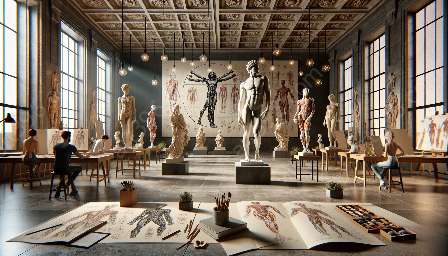Artists have long been fascinated by the intricacies of the human eye and its role in visual perception. Understanding the anatomy of the eye and its connection to artistic expression is fundamental for any artist seeking to portray the human form. This exploration will delve into the relationship between eye anatomy, visual perception, and art, while considering the impact of facial anatomy on artistic depiction.
The Complex Structure of the Eye
The human eye is a marvel of biological engineering, comprising several distinct components that work in unison to facilitate vision. The external anatomy of the eye includes the eyelids, sclera, and cornea, while the internal structures consist of the lens, iris, and retina. Each element contributes to the eye's ability to refract light, focus images, and transmit visual information to the brain.
Artists interested in portraying the human eye often study its intricate structure, understanding how light interacts with its various components to produce the images we perceive. By grasping the complexities of the eye's anatomy, artists can depict eyes more accurately and imbue their works with a deeper sense of realism.
Visual Perception and Its Influence on Art
Visual perception, the process by which the brain interprets and organizes sensory information from the eyes, plays a crucial role in art. Artists leverage their understanding of visual perception to create illusions of depth, form, and movement, allowing viewers to engage with their works on a profound level.
Exploring visual perception in art involves delving into concepts such as depth perception, figure-ground relationships, and the role of color and contrast in evoking emotional responses. By comprehending how the eye and brain collaborate to perceive and interpret visual stimuli, artists can manipulate these principles to create impactful, thought-provoking pieces.
Facial Anatomy for Artists
As the eyes are an integral part of the human face, an artist's understanding of facial anatomy greatly influences their depictions of the eyes and surrounding features. Elements such as the brow ridge, eyelids, and tear ducts all play vital roles in shaping the appearance and expression of the eyes within the context of the entire face.
By studying facial anatomy, artists can capture the nuances of expression and emotion that the eyes convey. Understanding the underlying structures of the face allows artists to portray the eyes in various states of emotion, from joy and sadness to determination and vulnerability, creating a deeper connection between the viewer and the artwork.
Artistic Anatomy: Bridging Science and Creativity
Artistic anatomy serves as the bridge between scientific understanding and creative interpretation. By combining knowledge of eye anatomy, visual perception, and facial anatomy, artists can infuse their works with a heightened sense of realism and emotional resonance.
Through the exploration of artistic anatomy, artists gain the ability to convey an unparalleled depth of expression in their depictions of the human eye. Whether focusing on the intricate details of the iris or capturing the interplay of light and shadow on the eyelids, artists who grasp the principles of artistic anatomy can imbue their works with a profound sense of life and vitality.
Ultimately, the exploration of eye anatomy and visual perception in art, in conjunction with an understanding of facial anatomy and artistic anatomy, offers artists a comprehensive framework for creating evocative, compelling renderings of the human form. By delving into the interconnected realms of science, perception, and creativity, artists can unlock new avenues of expression and captivate viewers with the mesmerizing beauty of the human eye.

